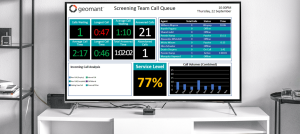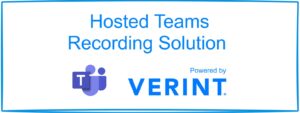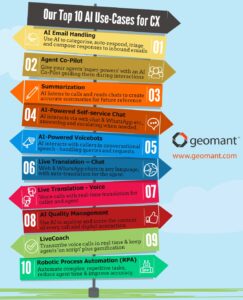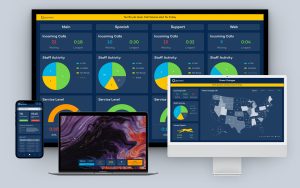Are you tracking the right contact center metrics?
Every day, modern businesses collect more valuable data than ever. We’re gathering information about employee productivity, company processes, and team efficiency. Perhaps the most crucial data of all is the information we pull from the contact center.
Within the contact center, you can learn all kinds of valuable information. You’ll discover how often your customers prefer to use self-service to deal with their problems, and what kind of channels they like for everyday communication. You could even learn what it takes to delight and impress your customers.
Of course, to leverage the right insights, you also need to know which metrics make the biggest impact. Today, we’re going to look at a series of contact center metrics every business needs to track.
Contents:
- First contact resolution
- Average handle time
- Service level and response time
- Abandoned call rate
- Average call transfer rate
- Cost per contact
- Agent schedule attrition
- Customer retention rate
- Customer satisfaction score

1. First Contact Resolution (FCR)
Today’s consumers want service that’s quick and effective. No one wants to repeat their issue to multiple agents and still end up waiting on hold while someone struggles to get to the bottom of it. First contact resolution is a crucial metric because it shows how effective you are at rapidly solving problems. When your agents can deliver results immediately, you benefit from:
- Happier returning customers
- Better thought leadership and reputation
- Improved efficiency (fewer call-backs and follow-ups)
- More calls answered
- Happier, more satisfied agents.
Of course, your ability to deliver results immediately depends on several things. If your agents don’t have access to the right specialist support, information, or training, they’ll get slower and slower when addressing issues.
Measuring and Improving FCR
To measure First Contact Resolution simply divide the number of cases you resolve with one call, by the number of calls your contact accents have resolved in a specific time. If you find that your FCR ratio isn’t great, you can improve it by:
- Providing agents with easy access to valuable information
- Establishing clear-cut processes on how to handle issues
- Regularly reviewing agent performance metrics
- Offering development and mentorship opportunities
- Improving routing to ensure calls are sent to the correct agent immediately
2. Average Handle Time (AHT)
Average handling time or average handle time measures the amount of time an agent spends addressing a customer issue. The time will include how long a customer spends on hold and the time that agents spend looking for information.
Crucially, a lower average handle time doesn’t always represent better performance. Too little time spent handling calls could mean that customers aren’t getting the right level of support. Too much time on a call, and your agents become inefficient.
The right “AHT” should balance delivering a meaningful, human experience to your customers, with quick results and call processing.
Measuring and Improving AHT
Calculating Average Handle Time is simple enough. Start by getting the total talk time, post-call activity, and hold time for your agent, and divide the number by the total number of managed calls. For instance, if an agent spends 100 minutes in calls, and they’ve handled 20 calls, then the AHT would be five minutes per interaction.
Measuring AHT gives you an insight into how quickly and effectively your agents are processing requests and dealing with issues. A fast average handling time is often a good design with the NPS or the Customer Satisfaction score of your customers is also high. You’ll need to look at this metric in the context of other measurements to see whether agents are just speeding through calls or delivering excellent experiences at a faster pace.
To improve average handle time, you can:
- Motivate agents with dashboards and wallboards showing their performance
- Provide comprehensive training and coaching programs
- Support agents with a good back-end environment for collaborating with teams (sometimes quick resolutions need specialist help)
- Use automation for automatic form-filling, recording, and call routing.
- Offer easy access to information an agent might need through knowledge bases and integration with other tools (like CRMs) in the contact center
3. Service Level and Response Time
Service level and response time are two-in-one metrics fundamental to the contact center. For years, we’ve known that faster response times lead to happier customers – no one likes waiting on hold. A good service level ensures you can answer more calls in a short space of time, improving the efficiency of your workplace.
Service level and response time can vary depending on a lot of factors. For instance, if your contact center solution is too complicated, your agents are going to be less effective at using it.
Measuring and Improving Response Time / Service Level
To measure your service level, you’ll need to figure out how many calls your agents answer in a specific number of seconds. Around 80% of calls into the center might be answered within 20 seconds, or 10 seconds, for instance. Remember, for an omnichannel contact center, you’ll be examining how quickly agents respond not just to calls, but messages and emails too.
The good thing about measuring and improving response time or service level is that you can also see how many customers are using specific avenues to contact your team. You can track things like how efficient your employees are when using various channels, and which channels they may need more training on. To improve response time, try:
- Implementing smart routing to avoid calls going to the wrong person
- Improving contact center technology for fast performance
- Providing extra training and guidance on problematic channels
- Use real-time tracking to show employees when they’re falling behind the average handling speed or time.
- Look into accessing more talent for channels that need extra support
4. Abandoned Call Rate
To retain happy customers, you need to avoid high abandoned call rates at all costs. The more your clients put the phone down or cancel their live chat session with you, the more frustrated they become. Unfortunately, customers are becoming increasingly impatient with contact centers. Around 60% of customers say they’ll hang up after waiting only around 1 minute.
There are a few things that might be ramping up your abandoned call rate. For instance, a customer getting through to the wrong agent and having to repeat their issue multiple times may get frustrated. Poor service level or average handling times may mean customers have to wait too long for support. Your customers may even become frustrated with the poor quality of the call.
Measuring and Improving Abandoned Call Rate
To measure the abandoned call rate in your company, divide the number of calls abandoned by the number of calls you receive in total. If you notice that a lot of people are leaving your queue, you can make a few changes to improve the situation, such as:
- Offering self-service solutions, so customers can solve more issues themselves
- Monitoring the quality of the calls in your CCaaS environment to ensure they sound great
- Adding alerts to agent dashboards when their queues are growing too long
- Sending notifications to supervisors in real-time when abandonment is high
- Offering “call back” options so customers can hang up until an agent is ready
- Providing training and support to help agents sort through issues with speed
5. Average Call Transfer Rate
For years, call transfers used to be a natural part of the contact center environment. Today, they’re growing increasingly less common, because customers are sick and tired of repeating themselves to different agents. While you may need to transfer a call from time to time, intelligent routing technology in the contact center should minimize this issue.
If you ever do need to transfer a call within the contact center, it will also be important to make sure that the call is sent to the correct agent, with the right information. A high-end contact center in the age of digital transformation should be able to use CRM technology to immediately pop customer information up on a screen for your agents.
Measuring and Improving Call Transfer Rate
Currently, 89% of customers become unhappy with your service when asked to repeat an issue to multiple representatives. We all want to feel like we’re getting the right response the first time around. To measure your average handling time, divide the number of calls transferred by the number of calls handled for your agents, then multiply the number by 100.
If your call transfer rate is too high, start by implementing an intelligent contact center routing system. Your routing technology should be able to send calls to agents based on their knowledge, availability, and other essential factors.
It’s also worth thinking about:
- Back-end collaboration: Building a contact center in a service like Microsoft Teams will allow team members to collaborate on issues rather than relying on a transfer.
- Excellent coaching and support: Better training should ensure your agents have the tools to answer questions and address issues fast.
- Access to information: Use AI bots and integrations to surface information fast.
6. Cost per Contact
Cost per contact is a metric that plays a crucial role in understanding the operational inefficiencies in your contact center. Measuring this metric correctly can help you to see where the contact center might need to be streamlined to improve return on investment. Cost per contact looks at all the expenses associated with running your contact center.
The idea behind cost per contact is you determine how much ROI you get for investing in the right tools. For instance, an omnichannel environment might be more expensive for handling calls, but it can also lead to a 25% increase in close rates, 10% growth year-over-year, and a 10% increase in average order value.
Measuring and Improving Cost per Contact
Measuring cost per contact involves dividing the total cost of running your business by the total number of contacts handled. Every time an agent picks up the phone, it costs something. From the software investments to agent wages, you’re always spending money.
If your cost per contact is high, then you need your return on investment to balance it out. You can improve your ROI by:
- Retaining existing customers: Investing in new customers is up to 25 times more expensive than retaining existing ones.
- Training employees in excellent customer service (to reduce churn)
- Supporting agents in delivering great experiences with the right tools, and access to useful information.
- Using CRM integrations to improve the personalization of customer service.
Even switching to a cloud-based contact center for managing customer experience can help to save you some serious cash. A cloud-based environment will be less expensive to manage than an on-premises solution and requires less maintenance too.
7. Agent Schedule Adherence and Attrition
Running a successful contact center doesn’t just mean retaining customers – it also means keeping hold of the most talented agents in your team, and ensuring they are working effectively. Calculating agent schedule adherence can help to determine how engaged your employees are. If you notice your agents are taking a lot of time off, this could even be a sign that you need to focus more on their well-being.
Studies constantly show that replacing an agent can be an expensive and time-consuming process. It costs an average of around $7,500 to replace an agent, and contact centers have some of the highest turnover rates of any career environment.
Measuring and Improving Agent Adherence and Attrition
To measure schedule adherence, divide the amount of time an agent is deemed to be available in your contact center service, by the time the agent is scheduled to be at work. You can use things like automated workforce management software to help with this process. You can look at agent attrition by examining the total number of employees leaving your business within a set period. If your agent adherence levels are low and your attrition levels are high, this is a good sign your employees simply aren’t happy in your team.
Keeping agents engaged and motivated in the new age of hybrid work can be a complicated process, but there are things you can do to boost your chances of happy employees. For instance, installing wallboards and digital dashboards into your business can motivate and inspire teams by showing them how their performance matches their colleagues.
Other options include:
- Providing regular training and development opportunities to show agents a future with your team
- Ensuring strong communication between every member of your staff, with plenty of video meetings, messaging, and calls.
- Having a strategy in place for protecting employee wellbeing, with regular check-ins from staff
- Collecting feedback from employees about how they feel when interacting with customers in your business and what kind of help they need
8. Customer Retention Rate (CRR)
It’s not just your employees you need to keep around. As mentioned above, retaining customers is far more effective (and less expensive) than finding new customers. It only takes around a 5% increase in retention to improve a company’s revenue by anywhere up to 95%. The more you spend on keeping customers happy, the more you can amplify your ROI.
Businesses often overlook how important it is to work on keep customers around with the contact center because they’re so busy looking for new potential clients. Tracking your customer retention rate can help you to determine whether you need to work harder at keeping customers loyal after you’ve convinced them to convert.
Measuring and Improving CCR
To calculate CCR, you’ll need to subtract the total number of customers your business has from the end of a specific time frame from the number of newly acquired customers in that same timeframe. Divide that number by the total number of clients you started with and multiple the result by 100.
Consumers have a huge number of companies to choose from when it comes to deciding who they want to interact with these days. Improving your retention rate means understanding your clients and figuring out what matters most to them.
To improve customer retention rate, focus on:
- Excellent training: Train your agents to deliver sensational experiences
- Regular analytics and insights: Gather as much information as you can from your CCaaS solution to understand the full customer journey.
- Omnichannel support: Make sure you can support your customer in every stage of the buyer journey.
- Implementing feedback loops: Collect as much feedback as you can from your customers on your service. For instance, you could use the NPS score to see if a client would recommend you to a friend.
9. Customer Satisfaction Score (CSAT)
Last, but not least, your customer satisfaction score shows you how happy your potential customers can be. This is why measuring your CSAT metric is so important. According to Microsoft, around 97% of global customers currently say that customer service impacts their brand loyalty and purchasing decisions.
Think about what you can do to deliver the best possible experience for your end-user. Customer satisfaction is often easier to access when you’re delivering the perfect combination of personalized service, speed, and simplicity. Clients want resolutions to their problems with as little headaches or effort as possible.
Measuring and Improving CSAT
Measuring CSAT is easiest when you have surveys to collect information from clients. Customer feedback surveys are often the best way to calculate this metric, as they allow you to understand how your customers feel about interacting with your staff. You can even use numerical scales to get an idea of how positively or negatively customers feel about any specific issue.
Allow your agents to track their individual CSAT rates with your dashboard, so they can remain motivated to keep driving their numbers up. At the same time, make sure your supervisors can see when agents are struggling, so they can step in and help customers with whisper mode, barge-in functions, and so on, to reduce the chances of churn. Improve CSAT by:
- Providing supervisors with the option to step in when agents need help
- Offering training on how to deal with difficult customers or concerns
- Tracking customer satisfaction score over time and recording conversations with the best agents for training purposes.
Do you need help tracking the right metrics for your contact center? Contact Geomant today to build your strategy for better customer experience.











